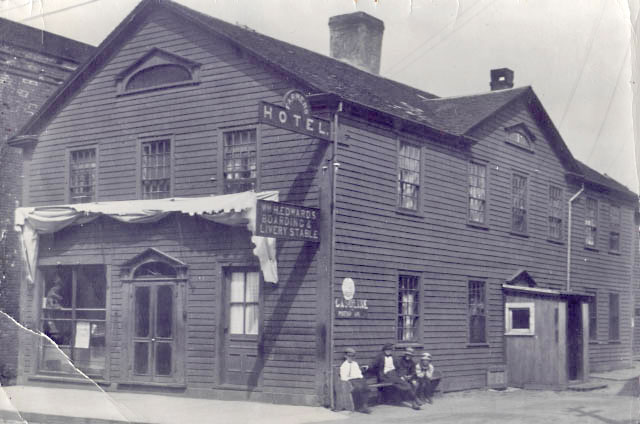
image for illustration: Sinclair Inn (know as Farmers Hotel – 1930) Annapolis Heritage Society, Public domain, via Wikimedia Commons
Some of the oldest structures in Canada are part of the National Trust Canada (NTC) Passport Places program, a Trust membership benefit that provides free access to 100 historic places in Canada, as well as 1000+ National Trust places abroad.
National Trust Canada writes:
Cupids Cove is the site of the first English settlement in Canada, established by Bristol merchant John Guy in 1610. Here, settlers cleared the land, fished, and attempted to establish a trade with the Beothuk. In fact, Guy’s meeting with the Beothuk in 1613 is one of the few positive interactions between the Indigenous group and European settlers. In addition to being the first English settlement, Cupids is also the site of the first sawmill and brewery in Canada (both built in 1613) and possibly the home to the first English child born in Canada. It was from Cupids that settlements spread to other parts of Conception Bay, including to Harbour Grace.
The archaeological site at Cupids was discovered in 1995 through archaeological survey, and since then four early 17th century features have been uncovered by archaeologists along with sections of the enclosure surrounding the settlement and thousands of artifacts. Visitors to Cupids Cove Plantation can view exhibits or take a guided tour to learn more about John Guy and his colony before heading to the archaeological site and view history as it’s uncovered.
One of the oldest wooden structures in all of Canada, Sinclair Inn might be the only remaining pre-expulsion Acadian structure in Annapolis Royal. Built c. 1708-1710, Sinclair Inn was established by tavern-keeper Frederick Sinclair in the 1780s when he combined two existing buildings into the one structure standing today. It was operational as an inn for over 150 years, and the building still retains much of the original material, including wattle-and-daub walls (a 6,000-year-old composite building method where woven lattice of ‘wattle’ is ‘daubbed’ with a sticky material, usually a combination of soil, clay, sand, animal dung, and straw).
In addition to being one of Canada’s oldest wooden structures, the Sinclair Inn also boasts 175-year-old masonic paintings, dubbed ‘the painted room’. They were discovered hidden under layers of wallpaper in the 2010s and are now open for public viewing. Today, the building is a striking example of restoration, and provides a glimpse into the original construction, materials, and evolution of the site. It is operated as a museum by the Annapolis Heritage Society. After visiting the Sinclair Inn, visitors can explore the rest of Annapolis Royal Heritage District and its history.
One of only three Chapels Royal in Canada and the oldest surviving church in Ontario, H.M. Royal Chapel of the Mohawks tells the story of Six Nations, the Haldimand Treaty, and even has a connection to the American Revolutionary War. Built in 1785 by the British Crown, Mohawk Chapel was given to the Mohawk people, led by Joseph Brant, for their support during the American Revolution. The Mohawks lent their support to the British Crown during the American Revolution in the hopes that the Crown would address issues of land encroachment by European settlers. After the war, the Mohawks left their homeland to resettle in Upper Canada on lands reserved for them in compensation for their loss in the Mohawk Valley.
The Chapel, which was given the Royal chapel designation in 1904, features a series of eight stained-glass windows that share the history of the Six Nations and their role in Canadian history. There is also a burying ground onsite where several important members of Six Nations have been buried, including Joseph Brant and his son John Brant. Visitors can take a guided tour of the chapel to learn more about its history and the history of Six Nations or explore the chapel at their own pace.
Hurtubise House, built in 1739 for Jean Hurtubise, is the oldest building in Westmount and has been occupied by six generations of the Hurtubise family until the last homeowner, Leopold Hurtubise, died in 1955. The house was sold to members of the Molson family (yes, those Molsons) who saved the building from demolition. The group later went on to form the Canadian Heritage of Quebec, who now manage and protect the building.
Hidden behind the facade of an otherwise unassuming building in downtown St. John’s is two massive brick and stone vaulted wine cellars filled with barrels of port wine. You might be wondering why port wine, which is made and aged in the Douro Valley of Portugal is in St. John’s, Newfoundland and Labrador. Well, legend says that in 1679, a ship loaded with port wine and bound for London drifted off course and eventually landed in St. John’s where the crew had to winter. The port wine was stored in caves in the Southside Hills of St. John’s, and when the vessel and its cargo of port wine finally reached England they discovered that the wine actually tasted better. It had gained a smoothness and flavour that it hadn’t had before, and since then Newman and Company aged their port wine in Newfoundland.
The building dates from c. late 1700s to early 1800, making Newman Wine Vaults one of the oldest standing structures in St. John’s. Today, Newman Wine Vaults tells the story of the 300-year-old connection between Newfoundland and Portugal. Visitors can enjoy a guided tour of the site with an interpreter, learn about the Newman family and their involvement in trade, explore history of barrel vaults and even try building on for yourself, and for those 19+ a small sample of Newmans Celebrated Port….
See more on Passport Places
